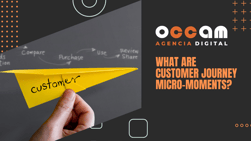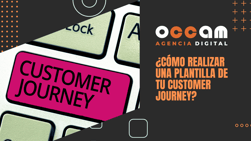Index Content
have you ever thought about the fact that every purchase we make involves a buying process prior to the moment of transaction?
If the universal maxim of personal growth is "know yourself", the marketing maxim should be "know your customers". During this journey, it is important to know what the consumer is like, what motivates them, their emotions and other relevant aspects, which can be reflected in the buyer persona.
what is the consumer journey?
We can define the customer journey asthe process that a person goes through to buy a product or service based on a need that is presented to them.
In the past, it was understood that the purchase cycle or process coincided completely with the sales cycle, but nowadays the consumer researches and informs himself before starting any commercial process.
To achieve a successful commercial journey we need to have our buyer personas very well defined before being able to build the customer journey. The buyer persona is the ideal customer profile on which we base an inbound marketing strategy, as the content and all actions must revolve around them.
The customer journey is divided into several phases that establish the customer journey:
- Awareness phase: In this phase the consumer realises that they have a need, but they do not know if they should do anything about it, what is causing it, how to solve it or how to define it.
The buyer persona in this phase is not yet looking for solutions or doing any research, until a time comes when they start looking for solutions.
- Marketing phase: In the discovering phase, the consumer is already aware that he or she has a need and is looking for information on the subject.
It is therefore a great opportunity for the marketing department to present educational content that meets this need and creates an urgency to solve it.
And then we are in the learning phase in which the consumer learns what solutions exist. The different options are taken into account and a list of them is created.
- Sales phase: The company has to prove that it is the best provider with the offer it has and will demonstrate that the investment will be profitable. And finally, we have the purchasing phase, in which the consumer prepares to own and maintain the solution.
From this point on, the subsequent phases are already the responsibility of customer service, operations, accounts, etc., and are based on maintaining customer satisfaction and successfully implementing the chosen solution.
what is the buyer journey?
The buyer journey comprises all the stages a consumer or potential customer goes through in order to buy a product or use your services. The buyer journey can be divided into four stages: awareness, consideration, decision and satisfaction.
The stages of this journey to establish the buyer persona are:
- Awareness: Here, the buyer realises that they have a problem. They will exhibit symptoms of a problem and their research at this stage is to understand their problem in order to define it. At this stage, they will not be looking for a solution.
- Consideration: Now, the individual is aware of their problem and has defined it. They want to know what is the best product or service to help them solve their problems or pain points. However, they are not yet interested in the final supplier - they don't want to hear from you yet.
- Decision: At this point the buyer has decided on a solution. They will compare and narrow down their options and finally decide on one. They know how to solve their problem and have researched specific products or services to achieve it.
- Delight: Show that you have gone the extra mile to create a memorable customer experience through things like giveaways, promotions, discounts. By fostering this emotional connection, customers are more likely to come back and be loyal in the long run.
Key differences
The key is that someone cannot become a customer unless they have gone through the buyer journey. They only become one at the end of the decision stage, once they have decided that you are the brand for them.
It is important that you know the differences between each of these instruments and can use them to exploit the benefits they bring to your marketing efforts.
- The main difference lies in the number of stages considered by each of the instruments. It is important to recognise the stages of customer relationships in order to focus efforts on each of them so that marketing campaigns can meet their objective. Recognising the entry and exit interaction points in each of the stages also allows you to consider how to promote those who have not progressed to the next stage.
- One difference that the customer journey and buyer journey offer us is that these instruments are an evolution so that the promotion of communication and relationship building can be successful and as a result they will bring us that the product evolves in its cycle, and the customer advances in the consumer's life cycle.
- Another big difference is the different focus on which the tactical development of a marketing strategy is centred. Considering the customer from a different point of view in order to determine relationship instances that lead us to close a marketing objective. In this way, knowledge of the customer becomes relevant when it comes to incorporating these tools for the development of marketing campaigns.
In conclusion, both cases have the same purpose of nurturing our buyer persona, i.e. potential customers, but they seek to achieve different results through different journeys.
Here is the link to the article 4 common mistakes when designing buyer personas in the IT sector.





